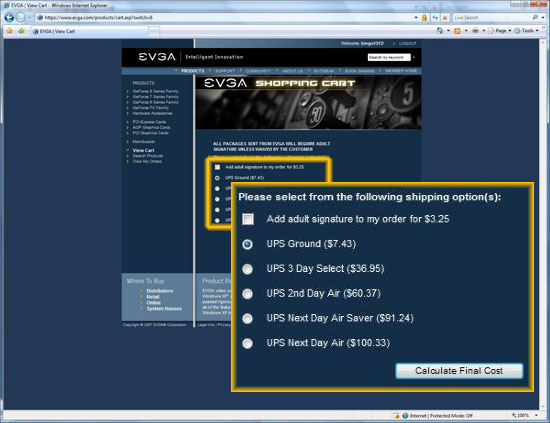Sparkle 8800 GT Passive: The Fastest Silent GPU in the World
by Anand Lal Shimpi on November 29, 2007 12:00 AM EST- Posted in
- GPUs
So about that pricing...
NVIDIA's GeForce 8800 GT launched to much praise from us, you all and other reviewers altogether. We've got a roundup of 8800 GTs in the works and today we're looking at a very special 8800 GT that those building silent PCs may be interested in. But, before we go much further must address the current situation with 8800 GT pricing and availability. There are a couple of givens:
1) GeForce 8800 GT availability is extremely limited, and
2) Pricing is much higher than expected
NVIDIA’s original target for the 8800 GT was $199 for the 256MB version and $249 - $259 for the 512MB version, and while 256MB cards are just now starting to appear in the worldwide market, 512MB cards just can’t be bought at those prices.
A quick look at Newegg shows that most cards are priced between $270 and $320, but almost all cards are out of stock at this time. If you're willing to spend a little more you can find cards selling for $330 - $350, but then you run into some very creative pricing on shipping.
Our own Gary Key took screen shots of his checkout cart at three different stores, pay attention to the rates for overnight shipping:

$100.33 for next day air shipping, does it come wrapped in Italian leather?

Don't be fooled by the colors, you'll be paying $380.78 for one of these bad boys

$340 for the card, $40 for shipping, you might as well buy an Xbox 360
If you want one of these things right away it looks like it'll cost you as much as $100 to get it shipped overnight. Who said patience doesn't pay off? Factor in some sort of speedy shipping and you're looking at close to a $400 investment for what was supposed to be a $250 card. With the fruits of capitalism come the inevitable sour grapes, the 8800 GT is a hot item and vendors will do whatever they can to maximize profit on it.
AMD is convinced that this is all a giant conspiracy by NVIDIA to hurt the launch of the Radeon HD 3800 series. Create buzz for a product that on paper destroys the Radeon HD 3870 but don't produce enough to actually make that happen. You have to admit, based on NVIDIA's promises the initial 8800 GT reviews were beyond glowing; but honestly, if we had to write the review today, even knowing the availability problems, the card still gets our recommendation - just at a higher price point.
The fact of the matter is that if you're patient and put in a pre-order with a vendor, you can actually get one of these things at less than $300, just not at $250. AMD should be happy because if the 8800 GT were actually a $250 card, the Radeon HD 3870 would have no place in the market. Instead, we've actually got a very nice set of options:
If you're spending less than $200, the only card to get is the Radeon HD 3850 and if you can find one at $220, the Radeon HD 3870 is good value. And then we've got the 8800 GT, which is effectively a $300 card if you're patient and more like $350 if you want one right away.
But if you're building a HTPC or just want a silent PC and happen to be a gamer, there's one particular flavor of 8800 GT that will interest you the most.
A Silent 8800 GT? Impossible
The night before our 8800 GT review went live, Derek called me and let me know that Sparkle sent along images of a passively cooled 8800 GT. Said one word: "impossible". I told him that it had to be a Photoshop because there was no way you were going to get an 8800 GT running without a fan, the card was simply too hot.
The 754M transistors that make up G92 were simply switching too fast and dissipating too much heat to be cooled by anything without a fan. Sparkle could’ve lowered the clocks, that would’ve made it possible, but I thought there was just no way at stock speeds. And Sparkle was promising a bone stock 8800 GT, sans fan.
I had honestly forgotten about the card until I started work on the 8800 GT roundup, and there it was, in its innocent white box:

I was still skeptical. We've received passively cooled video cards before that wouldn't even work at their stock speeds due to inadequate cooling. We had one 7600 GT in particular back when we were working on the Silent GPU Roundup that wouldn't even work at stock clock speeds in any 3D games, and we went through three samples before everyone determined that the card just couldn't be sold.
But in the back of my mind I was hopeful, after all, the idea of having a 8800 GT without a fan was simply too good. We've already benchmarked the 8800 GT and shown that it is faster than the vast majority of NVIDIA's lineup, easily offering 8800 GTX performance at a lower price. Since a silent 8800 GTX isn't possible, the 65nm G92 GPU on the 8800 GT could just make a few dreams come true.










55 Comments
View All Comments
darshahlu - Thursday, November 29, 2007 - link
Interesting article.111C seems a bit hot doesn't it? I don't think I would feel comfortable running any component in my computer at that temperature. Not only is it a fire and burn hazard as joked by the author, the temperature will negatively effect the life and stability of all other components. While I definitely agree that noise elimination is very important in computer design, if you are really concerned with noise you will likely go for a much cooler card, which won't increase overall ambient temperature of your case. I would be more impressed with a slower card that ran extremely cool.
I have an AMD Opteron w/ a huge Zalman heatsink. No case fans and all inlets covered up w/ acoustic damping material. PSU has an adjustable fan, which I always run on its lowest setting. Three hard drives: 1 10k Raptor for OS, two 1 terabyte WD green power drives running RAID mirror for redundant storage. The entire inside of my steel full tower case is lined with acoustic damping materials. The hottest component in my computer is my motherboard chipset, which runs at 130 F. (This is after I replaced the chipset fan/HS and applied arctic silver.) My CPU runs at 90 F, only 20 degrees hotter than ambient room temperature, and likely only a few degrees hotter than the inside of the case (I have cool and quiet enabled to throttle the CPU by 50% when idle). GPU is a 6600 or something, passively cooled. Never gets too hot to touch.
If I were to add an 111C component to my computer, every thing else would increase in temperature, and likely, I would have to add case fans/noise to keep things in control.
Darshan
qamca - Sunday, January 20, 2008 - link
Well, it occurs to me that the authors of this article have no intention on getting the coolest, but in somewhat beating the record of highest temperature out of this configuration....And if your PC case is so small and in such a mess and so crowded, I don't see why would anyone buy a passive cooled performance graphics card like this one... In fact I don't see why would anyone build any performance configuration in a case like this one??
Another test I read has successfully overclocked this card to 695/2000 without reaching 85C.
All you need is a tidy case and a well thought trough airflow in it.
So keep your pants on all you people scared of getting burned...
Griswold - Friday, November 30, 2007 - link
Its 111C inside the GPU core and not at the heatsink. Thats not really a fire or burn hazard.crazytyler34 - Friday, November 30, 2007 - link
100C boils water! when was the last time you touched boiling water without being burned?gerf - Saturday, December 1, 2007 - link
Again, you can't touch the GPU itself, only the heatsink. The heatsink is relatively cool compared to the GPU itself.The GPU is the source of the heat, and is naturally the hottest point. That heat is transferred to the heatsink (it sink the heat, see?), which cools down much faster than the GPU alone, due to large amounts of surface area. If there's enough airflow, the GPU could be 120C, and the heatsink (the area you can reach to touch) would be the same as room temperature.